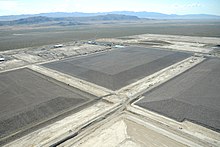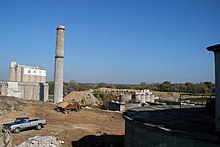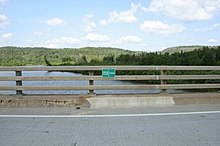


The Center for Land Use Interpretation (CLUI) is a non-profit research and education organization involved in exploring, examining, and understanding contemporary landscape issues in the United States. Founded in 1994, the CLUI organizes exhibitions, programs, field trips, and maintains an online archive and database to engage the public's understanding of the man-made landscape, and extent and impacts of human interactions with the surface of the Earth. The Center employs a variety of methods to this end, engaging in research, classification, extrapolation, and exhibition.
Mission
The mission statement of the CLUI is to "increase and diffuse knowledge about how the nation's lands are apportioned, utilized, and perceived."
Programs and projects
The CLUI also organizes exhibitions, research projects, and public programs. The Center's programs and projects cover many types of land uses in the US, including those related to agriculture, energy, industry, mining, communication, waste management, water resources, transportation, commerce, housing, recreation, and defense and preparedness.
The organization produces exhibitions about land use phenomenology in the US, and displays them at its exhibit locations and at other museum and non-commercial and educational venues. The CLUI produces publications, online resources, tours, lectures, and other public programs across the country. Activities of the Center are summarized and discussed in its annual newsletter, The Lay of the Land, in print and online.
The CLUI's main office is in Los Angeles where it operates a display space open to the public. It also operates other facilities and interpretive sites throughout the US, including in Wendover, Utah, at a former military facility, where the CLUI operated an artist residency program from 1996–2016; and the Desert Research Station in Hinkley, California.
CLUI is also the lead agency for the establishment of the American Land Museum, a network of exhibition sites in various interpretive zones across the country, which together form a dynamic portrait of the national landscape. According to Coolidge, the "man made landscape is a cultural inscription that can help us better understand who we are and what we are doing."
The CLUI organizes public field trips to sites of interesting and unusual land use. This has been documented in the book, Overlook: Exploring the Internal Fringes of America with the Center for Land Use Interpretation.
Reception
Neither an environmental organization nor an artist collective, CLUI resists categorization by maintaining a diverse, eclectic program of activities that invite a closer examination of "humankind's interaction with the Earth's surface". Writer and curator Lucy Lippard suggests the CLUI occupies "a tantalizing liminal space (that) has opened up between disciplines, between the arts, geography, history, archeology, sociology".
Culture writer Doug Harvey says that the Center is known for its "multidisciplinary examinations of human/landscape interaction, 'uncategorizable'". He refers to CLUI programs, such as the 2008 Post Consumed exhibit and bus tour as "subtly infused with formal beauty and wit ... unobtrusively informed by a patchwork of art historical, contemporary theoretical, sociological and geopolitical concerns and brimming with new information you don't know is here until the ride home."
According to the Los Angeles Times' architecture critic, Christopher Hawthorne, the CLUI's activities "all tell some version of the same story: how we shape and find meaning in the physical landscape around us, whether it's through oil exploration, architecture, map-making or freeway building."
The CLUI specializes in what writer Nicola Twilley describes as a "brand of perceptual revelation ... in which a previously overlooked site is made not only visible, but also legible as a guide to understanding larger, nationwide systems."
Online resources
The CLUI makes a collection of "unusual and exemplary" land use sites in the United States available online, through its database. The database compiles site-specific images taken by members of the CLUI, and are attributed to the CLUI Photo Archive. Also available through the CLUI website is the Morgan Cowles Archive, an online image resource that presents thematic photo collections, drawn from over 100,000 images of thousands of locations taken by a range of CLUI participants throughout the years, which exists though the support of "an endowment from the family and friends of Morgan Cowles, in his memory."
See also
References
- ^ "The Center for Land Use Interpretation". CLUI. Retrieved 25 November 2015.
- "Lecture | The Center for Land Use Interpretation". Swiss Institute. Retrieved 21 May 2020.
- "About the Center". The Center for Land Use Interpretation. Archived from the original on 3 October 2011. Retrieved 15 August 2018.
- "Center for Land Use Interpretation". Places Journal. Retrieved 28 June 2019.
- Strausbaugh, John (24 September 2006). "Take Nature, Add Humans, Observe Results". The New York Times. Retrieved 31 December 2018.
- "The Administrative Sublime, or The Center for Land Use Interpretation". Afterall Journal. 2006. Retrieved 15 August 2018.
- "Center for Land Use Interpretation: Wendover Residencies Collection CAE1041" (PDF). Center for Art and Environment, Nevada Museum of Art. Retrieved 1 January 2019.
- Pancin, Jean-Michel; Ardenne, Paul; Le Gac, Christophe (2008). "Wendover, no(s) limit(e)s". Blou, Monografik Editions.
- Clements, Alexis (3 April 2015). "In the State of Nevada, This Land Is Not Your Land". Hyperallergic. Retrieved 1 January 2019.
- Stringfellow, Kim (16 August 2012). "An Excursion Into LA's Mojave Hinterland at the CLUI Desert Research Station". KCET. Retrieved 12 July 2019.
- "The American Land Museum At Wendover, Utah". Cabinet. Property (10). Spring 2003. Retrieved 1 January 2019.
- "Matthew Coolidge-CLUI". Knowlton School, Ohio State University. October 2011.
- Coolidge, Matthew; Simons, Sarah; Rugoff, Ralph (2006). Overlook: Exploring the Internal Fringes of America with the Center for Land Use Interpretation. New York: Metropolis Books. p. 264. ISBN 1933045337. OCLC 65644361.
- Currey, Mason (1 September 2006). "This Land Is Your Land". Metropolis Magazine. Retrieved 1 January 2019.
- "Lucy Lippard, Imagine Being Here Now: Towards a Multicentered Exhibition Process". The Falmouth Convention. May 2010. Retrieved 17 October 2023.
- "Doug Harvey, The Big Nowhere". LA Weekly. November 1999. Retrieved 27 September 2016.
- "Doug Harvey, Wading in the Waste Stream with the Center for Land Use Interpretation". LA Weekly. August 2008. Retrieved 27 September 2016.
- "Christopher Hawthorne, Architecture review: 'Centers of the USA' at the Center for Land Use Interpretation". Los Angeles Times. January 2012. Retrieved 27 September 2016.
- "Nicola Twilley, Finding Tarzan at the Sanitation Department". Good Magazine. April 2011. Archived from the original on 2 October 2016. Retrieved 27 September 2016.
- "The Center for Land Use Interpretation". CLUI. Retrieved 5 March 2019.
- Rothstein, Adam (29 April 2015). "Morgan Cowles Archive at the Center for Land Use Interpretation". re:sculpt. International Sculpture Center. Archived from the original on 25 October 2019. Retrieved 5 March 2019.
External links
- Official Center for Land Use Interpretation website
- The CLUI Land Use Database
- Morgan Cowles Photo Archive
- Land art
- Land management in the United States
- Environmental organizations based in California
- Non-profit organizations based in California
- Organizations based in Los Angeles
- Architecture museums in the United States
- Museums in Los Angeles
- Natural history museums in California
- Science and technology in Greater Los Angeles
- Palms, Los Angeles
- Buildings and structures in Culver City, California
- Museums established in 1994
- 1994 establishments in California